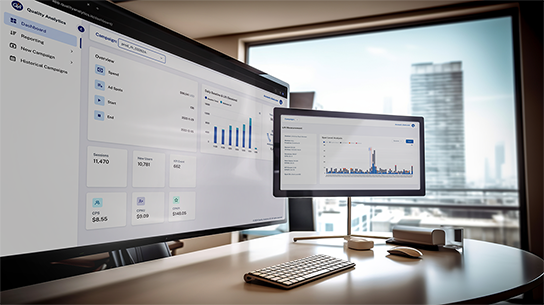
Measure what your commercials actually drive—then use the proof to optimize.
TV campaign measurement connects scheduled airings on broadcast, cable, and satellite to time-stamped outcomes (site visits, branded search, calls, leads, purchases). By comparing those outcomes to an expected baseline, you can quantify incremental lift and know which networks, dayparts, programs, markets, and creatives deserve more budget. This guide explains practical linear TV measurement—from the data you need to TV ad analysis methods, the right KPIs for TV advertising, and how measurement flows straight into TV analytics and weekly tv campaign tracking.
Also called tv advertising measurement (exposure + effect) and linear tv measurement (fixed-time airings), the goal is the same: prove impact and redeploy spend to what works.
TV Advertising Measurement: What It Means
TV advertising measurement is the discipline of isolating the effect of a TV campaign from background activity. Exposure metrics like reach, frequency, and impressions describe who saw the ad; effect metrics (lift in sessions, leads, sales, calls, branded search) show what the ad caused. Our approach to TV attribution measurement is built for linear TV attribution—where airings occur at fixed times—so results can be read immediately after a spot and over the hours/days that follow.
Linear TV Measurement: How to Measure TV Ad Effectiveness (Step by Step)
- Collect airing logs: exact timestamp, network/station, program (if available), creative, and market/DMA.
- Align outcomes: minute-level analytics (e.g., GA4), call logs, conversions—whatever signals matter to your business.
- Forecast a baseline: predict “what would have happened” without the airing using recent history, seasonality, day-of-week/hour effects, and known campaigns.
- Estimate lift: compare observed vs. forecast in tight windows after each spot (no arbitrary “credit windows”) to detect immediate spikes and decaying response.
- Attribute & roll up: aggregate lift by network, daypart, program, creative, market, and campaign to see where performance concentrates.
- Validate: check sample sizes, uneven schedules, holidays/politics, and digital overlap so you don’t confuse correlation with causation.
This is the foundation of our syncopated-response models—a practical form of tv commercial analytics for linear schedules.
Data You Need for Reliable Linear TV Measurement
- Airing logs: timestamps, creative names/IDs, network/station, market/DMA.
- Analytics: GA4 (sessions, new users, conversions), call tracking, CRM/transactions as applicable.
- Context (optional but useful): media costs/GRPs, program genres, promotions, seasonality notes.
We integrate with your workflows and TV media buying software outputs; CSV/Excel post-logs are fine.
KPIs for TV Advertising (What to Track)
Track both exposure and effect, but optimize on effect:
- Exposure: reach, frequency, impressions/GRPs (context for scale and cost).
- Effect: sessions, new users, branded searches, calls, leads, purchases, revenue, ROAS/ROI, CPA.
Break KPIs down by spot, network, daypart, creative, and market. This is actionable tv campaign tracking.
Immediate vs. Delayed Effects
Most response arrives quickly after an airing, but some persists as a decay. We measure both without blunt “time windows.” You’ll see which placements spark immediate action and which build momentum—crucial for pacing and budget shifts.
Reporting Breakouts That Matter
- Network & Daypart: prime vs. fringe; weekday vs. weekend.
- Program & Genre: contextual hotspots.
- Creative: CTA, offer, duration testing (e.g., :15 vs :30).
- Market/DMA: local strengths and spillover.
These breakouts turn tv analysis into an optimization roadmap.
Quality Checks (Avoid the Common Pitfalls)
- Sample size: don’t over-react to one or two airings.
- Uneven schedules: compare like-for-like (day, daypart) when judging creative.
- External noise: politics, holidays, big sports events can distort short windows.
- Channel overlap: account for concurrent digital pushes so lift isn’t double-counted.
Linear TV vs. CTV
We focus on linear TV. Live CTV with precise airing times (e.g., YouTube TV) can be measured using the same method. Pure on-demand environments (podcasts, app-served streams without timestamps) aren’t directly measurable with this approach.
TV Campaign Tracking & Optimization
Measurement proves impact; tv analytics operationalizes it—shifting budget to the highest-return networks, dayparts, markets, and creatives. That’s how a tv campaign compounds performance week after week.
Next steps: Learn TV Analytics & Campaign Optimization, see What is TV Attribution, and review our software. Evaluating partners? Here’s a list of TV measurement companies.
FAQ: TV Campaign Measurement
How do you measure TV ad effectiveness without clicks?
By aligning air-time to time-stamped outcomes and estimating incremental lift vs. a forecasted baseline. That’s tv attribution in a linear context.
Is this the same as TV attribution?
TV attribution is the framework for assigning credit; tv campaign measurement is the practice of quantifying lift by spot/network/daypart/creative/market. They work together.
Which KPIs matter most?
For DR: leads, purchases, calls, CPA, ROAS. For brand building: sessions, branded search, and sustained lift over time.
Can you measure local and national buys?
Yes—local reports by market/DMA; national aggregates by network/daypart with comparable lift metrics.
Do you integrate with TV media buying software?
Yes. We ingest post-logs (CSV/Excel) and align them with GA4 and other outcome data to power tv commercial analytics.